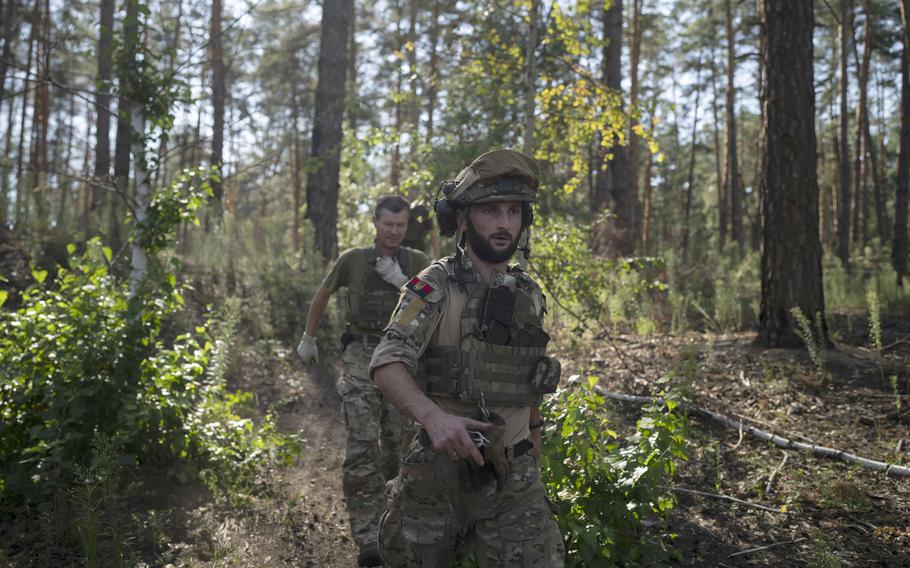
Ukrainian soldiers walk towards a howitzer position on the front line in the outskirts of Lyman, Ukraine, Tuesday, Aug. 15, 2023. (Bram Janssen/AP)
This is part two of a two-part series. Read part one here.
ZAPORIZHZHIA, Ukraine — Soldiers in the 47th Separate Mechanized Brigade waited for nightfall before piling — nervous but confident — into their U.S.-provided Bradley Fighting Vehicles. It was June 7 and Ukraine’s long-awaited counteroffensive was about to begin.
The goal for the first 24 hours was to advance nearly nine miles, reaching the village of Robotyne — an initial thrust south toward the larger objective of reclaiming Melitopol, a city near the Sea of Azov, and severing Russian supply lines.
Nothing went as planned.
The Ukrainian troops had expected minefields but were blindsided by the density. The ground was carpeted with explosives, so many that some were buried in stacks. The soldiers had been trained to drive their Bradleys at a facility in Germany, on smooth terrain. But on the mushy soil of the Zaporizhzhia region, in the deafening noise of battle, they struggled to steer through the narrow lanes cleared of mines by advance units.
The Russians, positioned on higher ground, immediately started firing antitank missiles. Some vehicles in the convoy were hit, forcing others behind them to veer off the path. Those, in turn, exploded on mines, snarling even more of the convoy. Russian helicopters and drones swooped in and attacked the pileup.
Troops, some experiencing the shock of combat for the first time, pulled back to regroup — only to attack and retreat, again and again on successive days, with the same bloody results.
“It was hellfire,” said Oleh Sentsov, a platoon commander in the 47th.
By day four, Gen. Valery Zaluzhny, Ukraine’s top commander, had seen enough. Incinerated Western military hardware — American Bradleys, German Leopard tanks, mine-sweeping vehicles — littered the battlefield. The numbers of dead and wounded sapped morale.
Zaluzhny told his troops to pause their assaults before any more of Ukraine’s limited weaponry was obliterated, a senior Ukrainian military official said.
Rather than try to breach Russian defenses with a massed, mechanized attack and supporting artillery fire, as his American counterparts had advised, Zaluzhny decided that Ukrainian soldiers would go on foot in small groups of about 10 — a process that would save equipment and lives but would be much slower.
Months of planning with the United States was tossed aside on that fourth day, and the already delayed counteroffensive, designed to reach the Sea of Azov within two to three months, ground to a near-halt. Rather than making a nine-mile breakthrough on their first day, the Ukrainians in the nearly six months since June have advanced about 12 miles and liberated a handful of villages. Melitopol is still far out of reach.
This account of how the counteroffensive unfolded is the second in a two-part series and illuminates the brutal and often futile attempts to breach Russian lines, as well as the widening rift between Ukrainian and U.S. commanders over tactics and strategy. The first article examined the Ukrainian and U.S. planning that went into the operation.
This second part is based on interviews with more than 30 senior Ukrainian and U.S. military officials, as well as over two dozen officers and troops on the front line. Some officials and soldiers spoke on the condition of anonymity to describe military operations.
Key findings from reporting on the campaign include:
• Seventy percent of troops in one of the brigades leading the counteroffensive, and equipped with the newest Western weapons, entered battle with no combat experience.
• Ukraine’s setbacks on the battlefield led to rifts with the United States over how best to cut through deep Russian defenses.
• The commander of U.S. forces in Europe couldn’t get in touch with Ukraine’s top commander for weeks in the early part of the campaign amid tension over the American’s second-guessing of battlefield decisions.
• Each side blamed the other for mistakes or miscalculations. U.S. military officials concluded that Ukraine had fallen short in basic military tactics, including the use of ground reconnaissance to understand the density of minefields. Ukrainian officials said the Americans didn’t seem to comprehend how attack drones and other technology had transformed the battlefield.
• In all, Ukraine has retaken only about 200 square miles of territory, at a cost of thousands of dead and wounded and billions in Western military aid in 2023 alone.
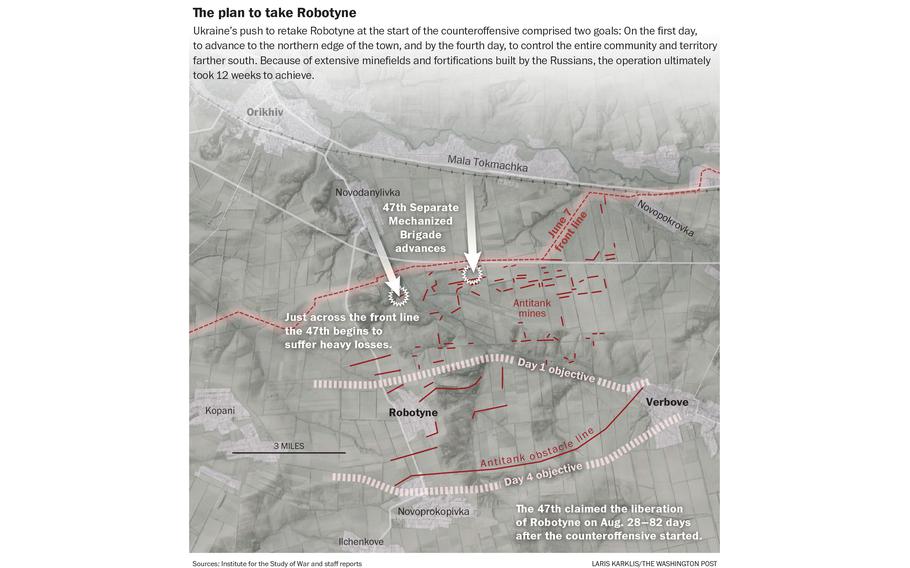
(Laris Karklis/The Washington Post)
Nearly six months after the counteroffensive began, the campaign has become a war of incremental gains. Damp World War I-style trenches lace eastern and southern Ukraine as surveillance and attack drones crowd the skies overhead. Moscow launches missile assaults on civilian targets in Ukrainian cities, while Kyiv is using both Western missiles and home-grown technology to strike far behind the front lines — in Moscow, in Crimea and on the Black Sea.
But the territorial lines of June 2023 have barely changed. And Russian President Vladimir Putin — in contrast to the silence he often maintained in the first year of the war — trumpets at every opportunity what he calls the counteroffensive’s failure. “As for the counteroffensive, which is allegedly stalling, it has failed completely,” Putin said in October.
Training for battle
On Jan. 16, five months before the start of Ukraine’s counteroffensive, Gen. Mark A. Milley, then chairman of the U.S. Joint Chiefs of Staff, visited soldiers with the 47th, just days after the unit arrived at the Grafenwoehr Training Area in Germany.
Milley, trailed by staff and senior military officials based in Europe, zigzagged across a muddy, chilly training range, bantering with Ukrainian soldiers and watching as they fired on stationary targets with rifles and M240B machine guns.
The installation had been used to train small groups of Ukrainian soldiers since 2014, when Russia invaded and illegally annexed Ukraine’s Crimea Peninsula. In anticipation of the counteroffensive, the effort was scaled up with one or more battalions of about 600 Ukrainian soldiers cycling through at a time.
In a white field tent, Milley gathered with U.S. soldiers overseeing the training, who told him they were trying to replicate Russian tactics and build some of the trenches and other obstacles the Ukrainians would face in battle.
“The whole thing ... for them to be successful with the Russians is for them to be able to both fire and maneuver,” Milley said, describing in basic terms the essence of the counteroffensive’s “combined arms” strategy, which called for coordinated maneuvers by a massed force of infantry, tanks, armored vehicles, engineers and artillery. If this were the United States or NATO, the operation also would have included devastating air power to weaken the enemy and protect troops on the ground, but the Ukrainians would have to make do with little or none.
The 47th had been selected to be a “breach force” at the tip of the counteroffensive and would be equipped with Western arms. But as Milley made his rounds and chatted with Ukrainian soldiers — from young men in their 20s to middle-aged recruits — many told him that they had only recently left civilian life and had no combat experience.
Milley kept silent. But later, in the meeting with U.S. trainers, he seemed to acknowledge the scale of the task ahead. “Give them everything you’ve got here,” he said.
The 47th was a newly created unit tabbed for the training in Germany. Ukraine’s military leadership had decided that more-experienced brigades would hold off the Russians during the winter, while fresh soldiers would form new brigades, receive training abroad and then lead the fight in the spring and summer. More than a year of war — with up to 130,000 troops dead or wounded, according to Western estimates — had taken a heavy toll on Ukraine’s armed forces. Even the most battle-hardened brigades were now largely composed of drafted replacements.
About 70 percent of the soldiers in the 47th didn’t have any battlefield experience, according to one senior commander in the brigade.
The 47th’s leadership was also strikingly young — its commander, though combat-hardened, was just 28 years old and his deputy was 25. Their youth had been billed as an advantage; young officers would absorb NATO tactics unaffected by the Soviet way of war that still infused parts of the Ukrainian military.
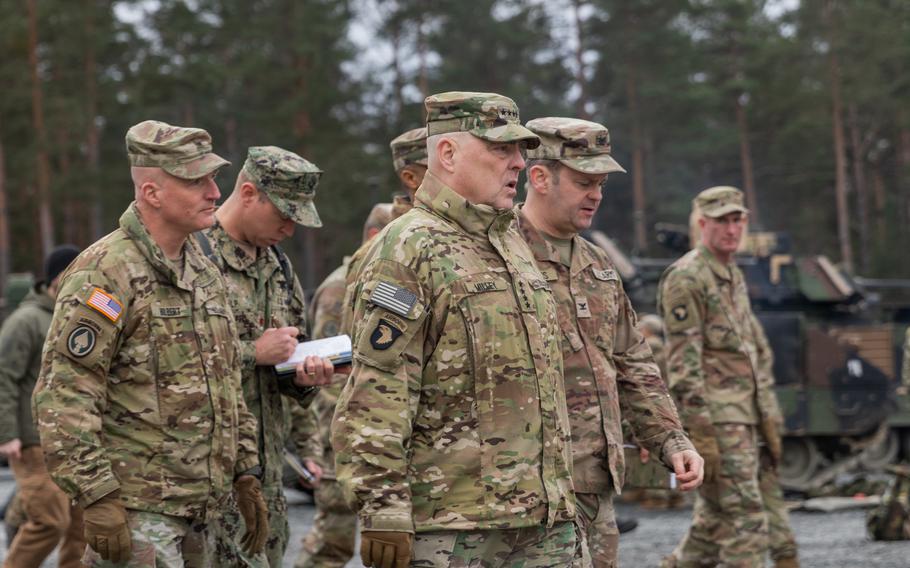
U.S. Army Gen. Mark A. Milley, then-U.S. Joint Chiefs of Staff chairman, meets with U.S. Army leaders responsible for the collective training of Ukrainians at Grafenwoehr Training Area, Grafenwoehr, Germany, Jan. 16, 2023. (Jordan Sivayavirojna/U.S. National Guard)
Some of the Ukrainian soldiers thought the American trainers didn’t grasp the scale of the conflict against a more powerful enemy. “The presence of a huge number of drones, fortifications, minefields and so on were not taken into account,” said a soldier in the 47th with the call sign Joker. Ukrainian soldiers brought their own drones to help hone their skills, he said, but trainers initially rebuffed the request to integrate them because the training programs were predetermined. Drone use was later added following Ukrainian feedback, a U.S. official said.
The U.S. program had benefits, Joker said, including advanced cold-weather training and how to adjust artillery fire. But much was discarded once real bullets flew. “We had to improve tactics during the battle itself,” he said. “We couldn’t use it the way we were taught.”
U.S. and Ukrainian officials said they never expected that two months of training would transform these troops into a NATO-like force. Instead, the intention was to teach them to properly use their new Western tanks and fighting vehicles and “make them literate in the basics of firing and moving,” a U.S. senior military official said.
No order to attack
When soldiers from the 47th returned to Ukraine in the spring, they expected the counteroffensive to start almost immediately. In early May, the brigade relocated closer to the front line, hiding their Bradleys and other Western equipment in the tree lines of rural Zaporizhzhia. The 47th’s insignia on vehicles was covered up in case locals sympathetic to Russia might reveal their location.
But weeks passed with no order to attack. Many in the unit felt the element of surprise had been lost. The political leadership “shouldn’t have been announcing our counteroffensive for almost a year,” said one unit commander in the 47th. “The enemy knew where we’d be coming from.”
Milley and other senior U.S. military officers involved in planning the offensive argued for the Ukrainians to mass forces at one key spot in Zaporizhzhia, to help them overcome stiff Russian defenses and ensure a successful breakthrough in the drive to Melitopol and the Sea of Azov. The Ukrainian plan, however, was to push on three axes — south along two distinct paths to the Sea of Azov, as well as in eastern Ukraine around the besieged city of Bakhmut, which the Russians had seized in the spring after a nearly year-long battle.
Ukrainian military leaders decided that committing too many troops to one point in the south would leave forces in the east vulnerable and enable the Russians to take territory there and, potentially, in Kharkiv to the northeast.
To split the Russian forces in Zaporizhzhia, Ukrainian marine brigades at the western edge of the neighboring Donetsk region would push south toward the coastal city of Berdyansk. That left the 47th and other brigades, part of what Ukraine referred to as its 9th Corps, to attack along the counteroffensive’s main axis, toward Melitopol.
The plan called for the 47th, and the 9th Corps, to breach the first Russian line of defense and take Robotyne. Then the 10th Corps, made up of Ukraine’s paratroopers, would join the fight in a second wave pushing south.
“We thought it was going to be a simple two-day task” to take Robotyne, said the commander of a Bradley Fighting Vehicle who goes by the call sign Frenchman.
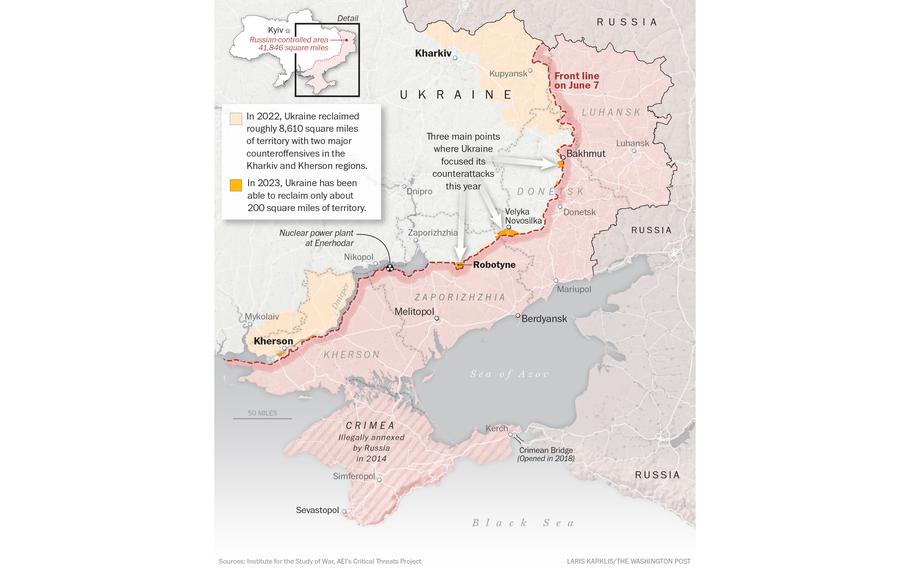
(Laris Karklis/The Washington Post)
Mining all approaches
Days after the counteroffensive launched, Oleksandr Sak, then the 47th’s commander, visited a Russian position his troops had captured. He noted anti-drone guns, thermal imagery scopes and small surveillance drones, among other abandoned materiel. “I realized the enemy had prepared,” he said. “We didn’t catch them off-guard; they knew we were coming.”
Also left behind were posters with Russian propaganda. One showed an image of men kissing in public with a red “X” over it, next to an image of a man and woman with two children. “Fighting for traditional families,” the poster said.
Sak also found a map that the Russians had used to mark their minefields. For just one part of the front — about four miles long and four miles deep — more than 20,000 mines were listed.
“I wouldn’t say it was unexpected, but we underestimated it,” Sak said. “We conducted engineering and aerial reconnaissance, but many mines were masked or buried. In addition to those by the front line, there were mines deeper into enemy positions. We passed enemy positions and encountered more mines where we thought there were none anymore.”
A chief drone sergeant in the 47th said that only on foot did they find remote-detonation traps, describing their discovery as a “surprise.”
U.S. military officials believed that Ukraine could have made a more significant advance by embracing greater use of ground reconnaissance units and reducing its reliance on imagery from drones, which weren’t able to detect buried mines, tripwires or booby traps.
The Zaporizhzhia region is largely composed of flat, open fields, and the Russians had chosen what high ground there was to build key defenses. From there, soldiers and officials said, Russian units armed with antitank missiles waited for convoys of Bradley Fighting Vehicles and German Leopard tanks. A mine-clearing vehicle always led the pack — and was targeted first with the help of reconnaissance drones.
“We constantly faced antitank fire and destroyed up to 10 Russian antitank guided missile systems per day,” Sak said. But, he added, “day after day, they pulled in more” of the systems.
Some 60 percent of Ukraine’s de-mining equipment was damaged or destroyed in the first days, according to a senior Ukrainian defense official. “Our partners’ reliance on armored maneuver and a breakthrough didn’t work,” the official said. “We had to change tactics.”
Within a week of the start of the counteroffensive, teams of sappers would work in twilight hours, when it was light enough for them to de-mine by hand but not so bright that the Russians could spot them. Once they cleared a small pathway, infantry would follow — a slow, grueling advance one wood line at a time.
Often, when Ukrainian soldiers reached a Russian outpost, they would find that it too had been booby-trapped with mines. And rather than withdraw, Russian forces held their positions even under heavy artillery bombardment, meaning the Ukrainians would have to engage in close combat with small arms to advance.
Throughout the Zaporizhzhia region, the Russians had deployed new units, called “Storm Z,” with fighters recruited from prisons. The former inmates attacked in human waves called “meat assaults” and were used to preserve more elite forces. Around Robotyne — the village the 47th was supposed to reach on the first day of the counteroffensive — they were mixed in with Russia’s 810th Guards Naval Infantry Brigade and other regular army formations.
“Robotyne was one of the toughest assignments,” a member of the 810th engineering unit said in an interview with a pro-war Russian blogger. “We had to go all out to prevent the enemy from breaking through. As sappers and engineers, we had to mine all approaches both for infantry and their vehicles.
“The famous Leopards are burning, and we tried to make sure they burn bright.”
Fleets of drones
Early in the assault on Robotyne, a Russian machine-gun nest carved into a building was preventing Ukrainian infantry from advancing. A drone company within the 47th sent up two modified racing drones strapped with explosives. One glided through a window and exploded. Another, guided by a pilot with the call sign Sapsan, spiraled into another room and detonated the ammunition inside, he said, also killing several enemy soldiers.
It was an early high point in the use of small drones like pinpoint artillery. Drone operators — wearing a headset that receives a video feed from the drone in real time — hunted for armored vehicles using first-person-view drones, known as FPVs. FPVs are so precise and fast that they can target the weak parts of vehicles, such as engine compartments and tracks, operators say.
But Russia is also deploying fleets of the same hand-built attack drones, which cost less than $1,000 each and can disable a multimillion-dollar tank. Unlike artillery ammunition, which is a precious resource for both Russia and Ukraine, the low-cost, disposable FPV drones can be used to hit small groups of infantry — navigated directly into trenches or into troops on the move.
Evacuating the wounded or bringing fresh supplies to a front-line position also became harrowing and potentially deadly tasks, often saved for nighttime because of the threat of drones.
“At first, our problem was mines. Now, it’s FPV drones,” said Sentsov, the platoon commander in the 47th. “They hit the target precisely and deal serious damage. They can disable a Bradley and potentially even blow it up. It’s not a direct explosion, but they can hit it in a way to make it burn — not only stop the vehicle but destroy it.”
U.S. military officials, drawing on their own doctrine, called for artillery to be used to suppress the enemy while mechanized ground forces advanced toward their objective.
“You’ve got to move while you’re firing the artillery,” a senior U.S. defense official said. “That sounds very fundamental, and it is, but that’s how you’ve got to fight. Otherwise, you can’t sustain the quantity of artillery and munitions that you need.”
But Ukrainian officials have said the ubiquity and lethality of different types of drones on both sides of the front line has been the biggest factor preventing the Ukrainians or the Russians from gaining significant ground for months.
“Because of the technical development, everything came to a standstill,” a high-ranking Ukrainian military official said. “The equipment that appears on the battlefield lives for a minute at the most.”

(The Washington Post)
Chaotic battlefield conditions
The 47th claimed the liberation of Robotyne on Aug. 28. Air assault units in Ukraine’s 10th Corps then moved in, but have been unable to liberate any other villages.
The front line has also grown static along the parallel drive in the south, where Ukrainian marines led the push toward the Azov Sea city of Berdyansk. After retaking the villages of Staromaiorske and Urozhaine in July and August, there have been no further gains, leaving Ukrainian forces far from both Berdyansk and Melitopol.
Throughout the summer, some of the fiercest fighting took place in a few square miles outside the eastern city of Bakhmut, along the third axis of the counteroffensive. Ukrainian war planners saw regaining control of the tiny village of Klishchiivka as key to attaining firing superiority around the southern edges of the city and disrupting Russian supply routes.
In July, police officers belonging to the newly formed Lyut, or “Fury,” Brigade — one of the brigades created last winter ahead of the counteroffensive — were deployed to the area. The brigade, made up of a mix of experienced police officers and recruits, was tasked with storming Russian positions in Klishchiivka, largely using gunfire and grenades.
Video footage of the Lyut Brigade’s operations, which was provided to The Washington Post, and interviews with officers who participated in the fighting reveal the intense and at times chaotic battlefield conditions.
In one bodycam video, from September, soldiers weave in and out of the ruins of homes as heavy shelling booms around them. Moving from one bombed-out house to another, the Ukrainian forces search the wreckage for any remaining Russian troops — screaming out for them to surrender before lobbing grenades into basements.
Days later, on Sept. 17, Ukraine announced that it had retaken Klishchiivka. But its recapture has not moved the lines around Bakhmut in any significant way since.
“Klishchiivka is actually a cemetery of equipment and Russian troops,” said the Lyut Brigade’s commander, police Col. Oleksandr Netrebko. But he also conceded: “Every square meter of liberated land is covered with the blood of our men.”
Frustration builds
With no big breakthrough, U.S. officials became increasingly agitated over the summer that Ukraine was not dedicating enough forces to one of the southern axes, given the American view of its strategic value.
In the north and the east, Gen. Oleksandr Syrsky controlled half of Ukraine’s brigades, which ran from Kharkiv through Bakhmut down to Donetsk. Meanwhile, Gen. Oleksandr Tarnavsky controlled the other half of active brigades, fighting along the two main axes in the south.
U.S. officials viewed the roughly 50-50 split of Ukrainian forces as the wrong mix and wanted more forces shifted to the south. “Of course the enemy is going to try to destroy your mine-clearing vehicles,” the senior U.S. military official said, adding that there were methods to camouflage them, including the use of smoke.
But assessing Kyiv’s approach and urging changes was a delicate task. One officer who did so was Gen. Christopher Cavoli, who as head of the U.S. European Command oversaw much of the Pentagon’s effort to train and equip Ukraine’s army. Milley, by contrast, often struck a more optimistic, motivational tone.
Cavoli, however, couldn’t reach Zaluzhny during part of the summer, a critical phase of the counteroffensive, three people familiar with the matter said. Cavoli declined to comment on the issue. A senior Ukrainian official noted that Zaluzhny spoke to Milley, his direct counterpart, throughout the campaign.
By August, Milley too had begun to air some frustration. He “started saying to Zaluzhny: ‘What are you doing?’ ” a senior Biden administration official said.
The Ukrainians were insistent that the West simply wasn’t giving them the air power and other weapons needed for a combined arms strategy to succeed. “You want us to to proceed with the counteroffensive, you want us to show the brilliant advances on the front line,” said Olha Stefanishyna, deputy prime minister for European and Euro-Atlantic integration of Ukraine. “But we do not have the fighter jets, meaning that you want us to throw our soldiers, you know, and accept the very fact that we cannot protect them.”
When allies said no, she said, “we heard ... ‘We are fine that your soldiers will be dying without support from the sky.’ ”
In an August video conference, soon followed by an in-person meeting near the Poland-Ukraine border, U.S. military officials pressed their case. They said they understood the logic of preoccupying Russian forces at different points on the front, but argued that deep advances would not come unless the Ukrainians massed more forces at a single point to move quickly and decisively.
Zaluzhny, in response, laid out the challenges in stark terms: no air cover, more mines than expected, and a Russian force that was impressively dug in and moving its reserves around effectively to plug gaps.
“I would not characterize that meeting as a ‘come to Jesus’ meeting and some massive drama — go left, go right,” Milley said in an interview. “I wouldn’t say that. I would say this is the normal course of business where professional leaders ... routinely meet to assess the situation and adjustments going on, on the ground.”
In July, as Ukraine ran low on artillery shells and the counteroffensive faltered, the Biden administration shifted position on providing Ukraine with artillery cluster munitions, with the president overruling State Department concerns that the reputational risks were too high given the weapon’s history of killing or wounding civilians. The final key decision on weapons transfers came in September, when the administration agreed to provide a variant of the Army Tactical Missile System, known as ATACMS. The missiles were not the deep-strike variant Kyiv had requested, with the United States instead opting for a shorter-range weapon that drops cluster submunitions.
While useful, Ukrainian officials said, neither the ATACMS launchers nor the cluster weapons have broken the battlefield deadlock.
Nor have other strategies. Throughout the counteroffensive, Ukraine has continued striking far behind enemy lines in an effort to weaken Russian forces and sow panic within Russian society. Kyiv isn’t permitted to use Western weapons for strikes on Russia, so a fleet of homegrown drones have been used instead. Some have been able to reach targets in Moscow, while others have damaged Russian oil depots along the Black Sea. Naval drones have also successfully hit ships in Russia’s Black Sea Fleet.
Ukraine has recently gained ground in the southern Kherson region, establishing troop positions on the eastern bank of the Dneiper River, but it’s unclear how much weaponry — artillery especially — has been moved across the river to threaten Russian supply lines stemming from Crimea.
Ukraine has stopped asking for more tanks and fighting vehicles, despite intensely lobbying for them throughout the first year of the war.
“A lot of the weapons,” a high-ranking Ukrainian military official said, “they were relevant last year.”
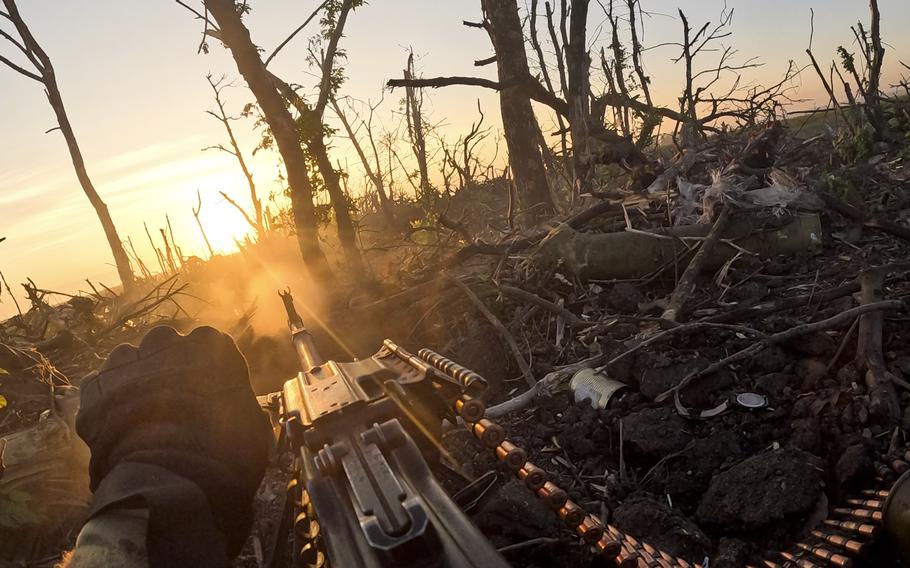
In this image taken from a video released by the 3rd Assault Brigade, a Ukrainian serviceman fires a machine gun towards Russian positions near Andriivka, Donetsk region, Ukraine, Aug. 27, 2023. (AP)
Frozen lines
In late September, in a meeting with NATO Secretary General Jens Stoltenberg, Ukrainian President Volodymyr Zelenskyy was asked why his military continued to commit so many forces to the east rather than the south. Zelenskyy said that if the Russians lost the east, they would lose the war, according to a person familiar with the conversation.
Zelenskyy acknowledged differing views among some of his commanders, the person said. But most senior Ukrainian military officials continued to believe that throwing more troops at one part of the front would not force a breakthrough.
Then in mid-October, the Russians tried just that in a fierce assault on the eastern Ukrainian town of Avdiivka, which sits in a geographically strategic pocket close to the Russian-occupied city of Donetsk. Now it was the Russians on the offensive, with four brigades moving in columns of tanks and personnel carriers, and descending on one narrow strip of the front.
Engineering vehicles with mine sweepers led the charge. It was exactly how the Ukrainians had started their counteroffensive. And similarly, the Russians suffered severe losses — Ukrainian officials claimed that more than 4,000 Russian troops were killed in the first three weeks of the assault — before switching to a dismounted approach, just as the Ukrainians had done.
In early October, the 47th Brigade, after a brief respite from the fighting, was rotated back into the counteroffensive. Zelenskyy had publicly vowed that Ukraine would continue its push through the winter, when the weather would make any advances even more difficult.
By the end of October, however, the troops of the 47th were suddenly moved east, to defend the northern flank of Avdiivka. The brigade’s Western weapons — German Leopard tanks and American Bradley Fighting Vehicles — went with them.
The relocation to Avdiivka was a surprise for the brigade, but it was also a signal that the operation in Zaporizhzhia was frozen along largely fixed lines. And behind their lines, the Russians had continued to build defensive fortifications over the summer and fall, according to satellite imagery. Around the village of Romanivske, southeast of Robotyne, antitank ditches and concrete pyramids were installed three-deep to blunt any further Ukrainian attempts to advance.
On Nov. 1, in an interview with the Economist, Zaluzhny acknowledged what had been previously unutterable the war had reached “a stalemate.”
“There will most likely, he said, “be no deep and beautiful breakthrough.”
Map sources: The Institute for the Study of War and the American Enterprise Institute’s Critical Threats Project; OpenStreetMap. Brady Africk, who analyzed satellite imagery from Copernicus Open Access Hub, provided fortifications data, which does not include all fortifications in Ukraine; some defenses predate Russia’s full-scale invasion.